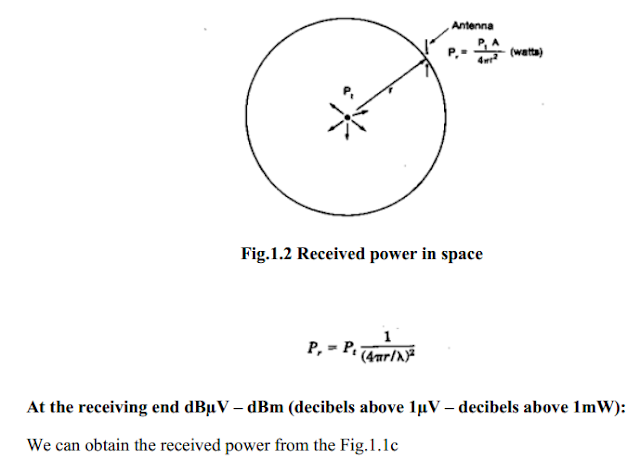Obtain the free space path loss from the transmitting end and the receiving end of the antenna. Derive the received power in dBm. How is the measured field strength converted into the receiver power?
1.Obtain the free space path loss from the transmitting end and the receiving end of the antenna. Derive the received power in dBm. How is the measured field strength converted into the receiver power?
Equivalent circuits of antennas:
The operating conditions of an actual antenna (Fig.1.1a) can be expressed in an equivalent circuit for both receiving (Fig. 1.lb) and transmitting (Fig.1.1c). In Fig. 1.1, Za is the antenna impedance; Zl is the load impedance, and Zt is the impedance at the transmitter terminal.
From the transmitting end (obtaining free-space path-loss formula):
Power Pt originates at a transmitting antenna and radiate out into space. (Equivalent circuit of a transmitting antenna is shown in Fig.1.1b.) Assume that an isotropic source Pt is used and that the power in the spherical space will be measured as the power per unit area. Thus power density, called the Pointing vector p or the outward flow of electromagnetic energy through a given surface area, is expressed as
Substitution of the above equation yields the free-space formula
 |
| Received power in space |
Measuring field strength and converting it to received power:
Converting field strength in decibels above 1µV/m to power received in decibels above 1mW at 850 MHz by a dipole with a 50-Ω load is -132 dB.
The notation “39-dBµV contour” is commonly used to mean 39 dB (µV/m) in cellular system design. Equation is valid only at a given frequency (850 MHz), for a given antenna (rnonopole or dipole E,, antenna), and for a given antenna load (50 Ω). Otherwise the field strength and the power have to be adjusted accordingly.
Measuring the voltage Vo at the load terminal (Fig. 1.lc) and converting to received power:
Given Pr = (Vo/RL), where RL = 50 Ω we can obtain a relationship
For example, if a voltage meter at Vo is 7 dBµV, then the received power is -100 dBm. Equation expresses a voltage-to-power antenna array ratio which varies with the load impedance but is independent of the frequency and the type of antenna.






